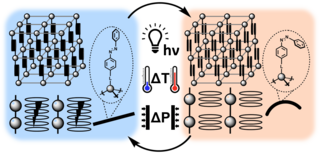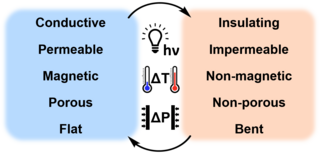
Stimuli-responsive materials
The Bartholomew Lab uses strategies and techniques from inorganic synthesis, organic synthesis, and materials science to design, generate, and study stimuli-responsive materials with properties that can be precisely controlled by either light, pressure, temperature, or the presence of guest molecules. We develop and investigate materials for applications in electronics, memory storage, sensing, microactuation, and solar energy. The materials we prepare and study are united by three common design themes: 1) control of properties via metal-templated manipulation of geometric structure, 2) combinations of inorganic and organic components to capitalize on the advantages of both areas, and 3) atomically precise synthesis for detailed structure-function understanding.

Switchable properties
We use a diverse set of measurement techniques to study the structure and switchable properties of our materials. Structural characterization is most often achieved by single-crystal X-ray diffraction or powder X-ray diffraction. Our lab’s 9 T Quantum Design Physical Properties Measurement System (PPMS) allows us to determine the magnetic and electrical transport behavior of our samples. Other frequently-used techniques in the group include cyclic voltammetry, differential scanning calorimetry, thermogravimetric analysis, scanning electron microscopy, and atomic force microscopy.